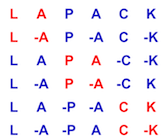 |
LAPACK 3.12.1
LAPACK: Linear Algebra PACKage
|
 |
LAPACK 3.12.1
LAPACK: Linear Algebra PACKage
|
| subroutine zckgsv | ( | integer | nm, |
| integer, dimension( * ) | mval, | ||
| integer, dimension( * ) | pval, | ||
| integer, dimension( * ) | nval, | ||
| integer | nmats, | ||
| integer, dimension( 4 ) | iseed, | ||
| double precision | thresh, | ||
| integer | nmax, | ||
| complex*16, dimension( * ) | a, | ||
| complex*16, dimension( * ) | af, | ||
| complex*16, dimension( * ) | b, | ||
| complex*16, dimension( * ) | bf, | ||
| complex*16, dimension( * ) | u, | ||
| complex*16, dimension( * ) | v, | ||
| complex*16, dimension( * ) | q, | ||
| double precision, dimension( * ) | alpha, | ||
| double precision, dimension( * ) | beta, | ||
| complex*16, dimension( * ) | r, | ||
| integer, dimension( * ) | iwork, | ||
| complex*16, dimension( * ) | work, | ||
| double precision, dimension( * ) | rwork, | ||
| integer | nin, | ||
| integer | nout, | ||
| integer | info ) |
ZCKGSV
!> !> ZCKGSV tests ZGGSVD: !> the GSVD for M-by-N matrix A and P-by-N matrix B. !>
| [in] | NM | !> NM is INTEGER !> The number of values of M contained in the vector MVAL. !> |
| [in] | MVAL | !> MVAL is INTEGER array, dimension (NM) !> The values of the matrix row dimension M. !> |
| [in] | PVAL | !> PVAL is INTEGER array, dimension (NP) !> The values of the matrix row dimension P. !> |
| [in] | NVAL | !> NVAL is INTEGER array, dimension (NN) !> The values of the matrix column dimension N. !> |
| [in] | NMATS | !> NMATS is INTEGER !> The number of matrix types to be tested for each combination !> of matrix dimensions. If NMATS >= NTYPES (the maximum !> number of matrix types), then all the different types are !> generated for testing. If NMATS < NTYPES, another input line !> is read to get the numbers of the matrix types to be used. !> |
| [in,out] | ISEED | !> ISEED is INTEGER array, dimension (4) !> On entry, the seed of the random number generator. The array !> elements should be between 0 and 4095, otherwise they will be !> reduced mod 4096, and ISEED(4) must be odd. !> On exit, the next seed in the random number sequence after !> all the test matrices have been generated. !> |
| [in] | THRESH | !> THRESH is DOUBLE PRECISION !> The threshold value for the test ratios. A result is !> included in the output file if RESULT >= THRESH. To have !> every test ratio printed, use THRESH = 0. !> |
| [in] | NMAX | !> NMAX is INTEGER !> The maximum value permitted for M or N, used in dimensioning !> the work arrays. !> |
| [out] | A | !> A is COMPLEX*16 array, dimension (NMAX*NMAX) !> |
| [out] | AF | !> AF is COMPLEX*16 array, dimension (NMAX*NMAX) !> |
| [out] | B | !> B is COMPLEX*16 array, dimension (NMAX*NMAX) !> |
| [out] | BF | !> BF is COMPLEX*16 array, dimension (NMAX*NMAX) !> |
| [out] | U | !> U is COMPLEX*16 array, dimension (NMAX*NMAX) !> |
| [out] | V | !> V is COMPLEX*16 array, dimension (NMAX*NMAX) !> |
| [out] | Q | !> Q is COMPLEX*16 array, dimension (NMAX*NMAX) !> |
| [out] | ALPHA | !> ALPHA is DOUBLE PRECISION array, dimension (NMAX) !> |
| [out] | BETA | !> BETA is DOUBLE PRECISION array, dimension (NMAX) !> |
| [out] | R | !> R is COMPLEX*16 array, dimension (NMAX*NMAX) !> |
| [out] | IWORK | !> IWORK is INTEGER array, dimension (NMAX) !> |
| [out] | WORK | !> WORK is COMPLEX*16 array, dimension (NMAX*NMAX) !> |
| [out] | RWORK | !> RWORK is DOUBLE PRECISION array, dimension (NMAX) !> |
| [in] | NIN | !> NIN is INTEGER !> The unit number for input. !> |
| [in] | NOUT | !> NOUT is INTEGER !> The unit number for output. !> |
| [out] | INFO | !> INFO is INTEGER !> = 0 : successful exit !> > 0 : If ZLATMS returns an error code, the absolute value !> of it is returned. !> |
Definition at line 195 of file zckgsv.f.